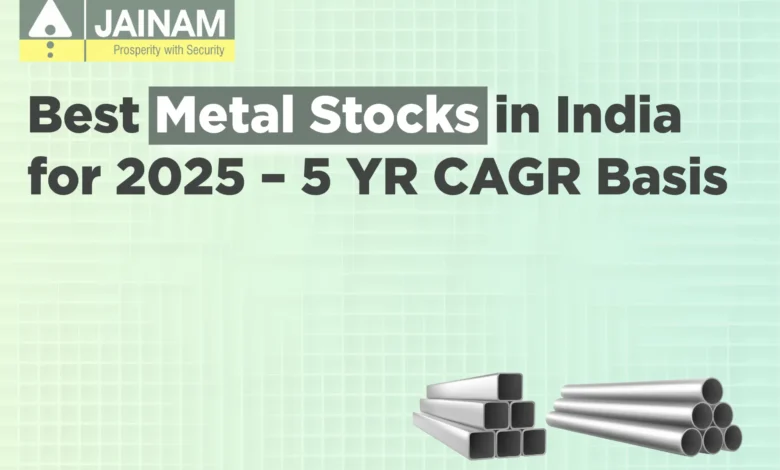
[ad_1]

Introduction
India’s metal industry is remarkably diverse. It spans base metals like copper and aluminum to specialty metals that are essential for cutting-edge applications in technology and renewable energy. Industry’s strength lies in its ability to cater to a rapidly growing domestic market, as well as its competitive export capabilities. With major stock exchanges listing numerous metal stocks NSE, investors are presented with a wealth of options ranging from blue-chip companies to emerging players. Understanding these trends and the growth drivers within the sector is key to identifying the best metal stock that promises long-term value.
What are Metal Stocks?
Metal stocks refer to the shares of companies involved in the mining, production, & distribution of metals such as iron ore, copper, aluminum, and precious metals like gold and silver. These companies are pivotal to the global economy, supplying essential materials for various industries, including construction, manufacturing, and technology. Investing in metal stocks today can be lucrative, as the demand for metals is often driven by economic growth and infrastructure development. As economies expand and industrial activities increase, the need for metals rises, making metal stocks a potentially rewarding investment.
Types of Metal Stocks
There are several types of metal stocks, each catering to different segments of the market:
- Industrial Metal Stocks: These companies produce metals used in industrial applications, such as copper, aluminum, and zinc. These metals are fundamental to construction, manufacturing, and transportation systems.
- Precious Metal Stocks: Companies in this category produce precious metals like gold, silver, and platinum. These metals are often used in jewelry, coins, and other luxury items, and they also serve as a store of value.
- Mining Stocks: These companies are involved in the extraction and processing of metals from the earth. They play a crucial role in supplying raw materials to various industries.
- Metal Processing Stocks: These companies refine and process metals into various forms, such as sheets, wires, and alloys, making them suitable for different industrial applications.
Each type of metal stock offers unique investment opportunities and risks, allowing investors to diversify their portfolios based on their risk tolerance & investment goals.
Benefits of Investing in Metal Stocks
Investing in metal stocks can provide several benefits, including:
- Diversification: Metal stocks can add diversity to a portfolio, as their performance is often linked to industrial and economic trends rather than traditional market fluctuations.
- Growth Potential: The demand for metals is expected to increase, driven by global economic growth and infrastructure development. This growth can lead to higher stock prices and potential capital gains.
- Income Generation: Many metal companies pay dividends, providing a regular income stream for investors. This can be particularly attractive for those seeking a steady income.
- Hedge Against Inflation: Metal prices often rise with inflation, making metal stocks a potential hedge against inflationary pressures. This can help preserve the purchasing power of your investments over time.
You may also want to know the Best Paper Stocks in India for 2025
The 5-year Compound Annual Growth Rate is a vital metric that indicates a company’s average annual growth over five years. In the volatile metal sector, where short-term price fluctuations can be influenced by global economic events or commodity price swings, CAGR provides a clearer picture of a company’s long-term performance. By evaluating the CAGR of metal companies’ stock, investors can identify firms that have not only weathered market turbulence but have also consistently delivered sustainable growth. This metric is especially useful when comparing companies on a level playing field, filtering out noise and focusing on true market leaders.
Over the past five years, certain companies in the metal sector have demonstrated exceptional resilience and growth. Evaluating the CAGR of mining companies can provide insights into their long-term growth potential. Based on historical data and performance analysis, here are some of the top metal stocks in India that have excelled in terms of 5-year CAGR:
1. JSW Steel Ltd
About: JSW Steel is mainly involved in the manufacturing and sale of iron & steel products. It serves as the flagship company of the diversified JSW Group, a US$23 billion conglomerate with interests spanning energy, infrastructure, paints, cement, sports, & venture capital. Its broad product portfolio includes hot-rolled, cold-rolled, galvannealed, galvanised/galvalume, pre-painted, tinplate, electrical steel, TMT bars, and wire rods.
Market cap: ₹ 2,32,746 Cr.
CAGR: 41.1 %
Pros:
- The company has been maintaining a healthy dividend payout of 25.1%
2. Tube Investments of India Ltd
About: Tube Investments of India Limited (TII) is a leading Indian manufacturer catering to key industries like automotive, railways, construction, mining, and agriculture. The company operates through three core verticals: Engineering, Metal Formed Products, and Bicycles. As part of its growth strategy, TII has expanded into the TMT bars and truck body building segments and is also exploring opportunities in optic lenses and advanced vision systems for the automotive sector.
Market cap: ₹ 49,967 Cr.
CAGR: 52.4 %
Pros:
- The company has delivered good profit growth of 38.3% CAGR over the last 5 years
- The company has a good return on equity (ROE) track record: 3 Years ROE 27.2%
3. Steel Authority of India Ltd
About: Steel Authority of India Limited is one of the country’s largest steel producers and holds the prestigious Maharatna status among India’s Central Public Sector Enterprises. The company operates five integrated steel plants and three special steel units, primarily located in the eastern and central regions, close to key raw material sources. SAIL offers a wide range of iron and steel products across various segments.
Market cap: ₹ 43,453 Cr.
CAGR: 31.8 %
Pros:
- Stock is trading at 0.77 times its book value
- The company has been maintaining a healthy dividend payout of 28.3%
4. Jindal Stainless Ltd
About: Jindal Stainless Ltd is one of the largest manufacturers of Stainless Steel flat products in Austenitic, Ferritic, Martensitic, & Duplex grades in India. These products are used in a variety of industries, such as automobiles, railways, construction, consumer goods, etc.
Market cap: ₹ 43,252 Cr.
CAGR: 78.5 %
Pros:
- The company has delivered good profit growth of 79.0% CAGR over the last 5 years
- The company has a good return on equity track record: 3 Years ROE 25.5%
- Debtor days have improved from 35.8 to 26.8 days.
5. APL Apollo Tubes Ltd
About: APL Apollo Tubes Limited (APL Apollo) is one of India’s leading branded steel product manufacturers. Headquartered in Delhi NCR, the company operates 10 manufacturing units producing over 1,500 variants of MS Black Pipes, Galvanised Tubes, Pre-Galvanised Tubes, Structural ERW Steel Tubes, and Hollow Sections. These products cater to diverse sectors such as urban infrastructure, housing, irrigation, solar energy, greenhouses, and engineering applications.
Market cap: ₹ 40,659 Cr.
CAGR: 60.9 %
Pros:
- The company has delivered good profit growth of 37.5% CAGR over the last 5 years
- The company has been maintaining a healthy dividend payout of 18.9%
- The company’s median sales growth is 23.7% over the last 10 years
Note: Specific company names can be inserted based on detailed market research and the latest financial reports.
Open free demat account in 5 minutes
The metal sector in India comprises companies of varying sizes, each with its risk-reward profile. Diversifying your investments across different market cap segments can help manage risk while capturing the sector’s overall growth potential.
Additionally, companies involved in the production of critical metals, essential for low-carbon technologies, have shown significant growth.
Large Cap Metal Stocks
These are well-established companies that offer stability and consistent returns. They are often featured in the Nifty Metal Index stocks list and benefit from strong brand equity and market dominance.
JSW Steels, TATA Steels, Jindal Steels, and Shyam Metallics are some names under large-cap metal stocks.
Additionally, international trade dynamics can significantly impact the performance of large-cap metal stocks.
Mid Cap Metal Stocks
Mid cap stocks represent companies that are on the cusp of scaling up. They typically exhibit higher growth potential with moderate risk, making them an important part of any comprehensive list of metal stocks in India. Godawari Power, Jai Balaji Industries, and NMDC Steels are named under mid cap metal stocks.
Additionally, mid-cap metal stocks often play a crucial role in the global distribution of in-use stock, impacting resource management.
Small Cap Metal Stocks
Small cap stocks, while riskier due to their volatility, can offer significant upside if the companies succeed in expanding their operations. These stocks are often the breakout metal stocks today that can deliver extraordinary returns if they capture a larger market share.
Bansal Wire, Surya Roshni, and Kalyani Steels are some names under small-cap metal stocks.
A balanced portfolio across these segments can help mitigate risks while ensuring exposure to the high-growth potential of the metal sector. Small cap metal stocks can benefit significantly from economic growth in more developed countries.
For those tracking metal stocks in NSE, technical analysis provides additional insights that complement fundamental evaluations. Key technical indicators to watch include:
- Volume Patterns: A surge in trading volumes can indicate renewed investor interest or significant market moves, often preceding major price changes.
- Moving Averages & RSI (Relative Strength Index): These tools help identify momentum shifts. Moving averages smooth out price data, while RSI signals potential overbought or oversold conditions, guiding potential buy or sell decisions.
- Support and Resistance Levels: Analysing these levels helps in understanding price trends and determining entry and exit points. This is especially useful when evaluating scenarios around why metal stocks are falling.
Technical indicators are crucial for evaluating metal stocks and making informed investment decisions.
By combining technical analysis with fundamental metrics like CAGR, investors can adopt a more balanced approach to portfolio management.
The metal and mining sector is subject to cyclical trends driven by economic cycles, regulatory changes, and technological advancements. However, the long-term outlook remains positive due to several factors:
- Global Demand: Urbanisation, industrialisation, and the surge in renewable energy projects drive sustained demand for metals. This global need supports the long-term potential of metal stocks in NSE. Additionally, the increasing demand for metal-containing products is driving the long-term potential of the sector.
- Policy Reforms: Recent reforms in mining and environmental regulations, combined with increased government investments in infrastructure, further enhance the growth prospects of metal and mining stocks in India.
- Technological Innovations: Advancements in production techniques and automation are improving operational efficiency, which can lead to better margins and growth prospects over time.
These factors contribute to a robust outlook for the sector, encouraging investors to consider metal stocks as part of a diversified, long-term investment strategy.
Despite their long-term potential, metal stocks can experience short-term declines. Understanding the underlying reasons helps investors navigate temporary setbacks and make informed decisions. Some common factors include:
- Global Economic Uncertainty: Trade tensions, economic slowdowns, and geopolitical issues can reduce demand for metals, leading to lower stock prices.
- Regulatory Hurdles: Changes in environmental and mining regulations can disrupt production processes or increase operational costs, impacting profitability.
- Supply-Demand Imbalances: Periods of oversupply or subdued demand can depress metal prices, affecting the financial performance of companies in the sector. Fluctuations in the prices of other metals, such as aluminum and copper, can also impact the performance of metal stocks.
- Currency Fluctuations: Since many metals are traded on a global scale, currency fluctuations can affect export competitiveness and overall profitability.
By understanding these factors, investors can remain focused on the long-term fundamentals and avoid making hasty decisions during periods of market volatility.
Why Iron Ore Stocks Are Falling? An Analysis
Iron ore miner stocks have declined recently due to speculation about potential steel production cuts in China, with reports hinting at a 50 million tonne reduction in 2025. However, analysts believe this market reaction is exaggerated, as no mandated cuts are expected this year. Instead, any production decline will likely result from weaker demand and lower prices.
China’s steel policy remains market-driven, using tools like pricing and green finance to influence output. While iron ore prices are under pressure, short-term support may come from supply disruptions, seasonal construction demand, and low steel inventories.
If capacity cuts do occur, they may boost steel mill profitability and affect lower-grade iron ore pricing, rather than sharply reducing overall demand. Recent temporary environmental curbs in cities like Tangshan and Tianjin have added to market uncertainty.
India is a leading producer of most metals, which strengthens the investment potential of its metal stocks.
Investing in metal stocks requires a thorough understanding of the metal sector stocks and the companies involved. Here are some steps to consider:
- Research: Start by researching the metal sector, including the types of metals, their uses, and the companies involved. Understanding the market dynamics & the factors influencing metal prices is crucial.
- Choose a Brokerage Account: Open a brokerage account with a reputable online broker to buy and sell metal stocks. Look for a platform that offers comprehensive research tools and low trading fees.
- Select Metal Stocks: Choose metal stocks that align with your investment goals and risk tolerance. Consider factors such as the company’s financial health, growth prospects, and market position.
- Monitor and Adjust: Continuously monitor the performance of your metal stocks and adjust your portfolio as needed. Stay informed about market trends, economic indicators, and company-specific news to make informed decisions.
By following these steps, you can build a well-rounded portfolio that leverages the growth potential of the metal sector stocks.
Large Cap Metal Stocks (High Market Cap & Liquidity)
- Tata Steel Ltd
- JSW Steel Ltd
- Hindalco Industries Ltd (Aluminum & Copper)
- Vedanta Ltd (Zinc, Aluminum, Copper, Iron Ore)
- Steel Authority of India Ltd (SAIL)
- NMDC Ltd (Iron Ore)
- National Aluminium Company Ltd (NALCO)
Mid & Small Cap Metal Stocks
- Jindal Steel & Power Ltd
- MOIL Ltd (Manganese Ore)
- Hindustan Zinc Ltd (Zinc & Lead, majority owned by Vedanta)
- Ratnamani Metals & Tubes Ltd (Specialty steel & tubes)
- Welspun Corp Ltd (Pipes and steel solutions)
- APL Apollo Tubes Ltd (Steel pipes & structural products)
- Godawari Power & Ispat Ltd (Integrated steel & power)
- Jindal Stainless Ltd (Stainless steel)
Metal-Related/Allied Stocks
- Maithan Alloys Ltd (Ferro Alloys)
- Sandur Manganese & Iron Ores Ltd
- Shyam Metalics and Energy Ltd
- Electrosteel Castings Ltd
When evaluating metal stocks, consider the following key metrics:
- Revenue Growth: Look for companies with increasing revenue, indicating growing demand for their metals. Consistent revenue growth is a positive sign of a company’s market strength.
- Profit Margins: Companies with high profit margins are better positioned to weather market fluctuations. High margins indicate efficient operations and strong pricing power.
- Debt-to-Equity Ratio: A lower debt-to-equity ratio indicates a company’s financial stability. Companies with manageable debt levels are less vulnerable to economic downturns.
- Return on Capital Employed (ROCE): A higher ROCE ratio indicates a company’s ability to generate profits from its capital. This metric helps assess the efficiency of a company’s capital use.
- Dividend Yield: Consider companies with a consistent dividend policy and a reasonable dividend yield. Dividends can provide a steady income stream and signal financial health.
- Stock Price: Monitor the stock price and its volatility to determine the best time to buy or sell. Understanding price trends and market sentiment can help you make informed investment decisions.
By focusing on these key metrics, you can better evaluate the potential of metal stocks and make more informed investment choices.
Conclusion
The metal and mining sector in India is a dynamic arena with both significant growth potential and inherent cyclical risks. With strong 5-year CAGR figures, many of the top metal stocks in India have proven their ability to deliver consistent returns over time. Whether you prefer the stability of large caps or the growth potential of small caps, a diversified portfolio that includes a mix of Nifty metal stocks can be a strategic addition for long-term wealth creation. Including nonferrous metals in a diversified portfolio can enhance growth potential and reduce risk.
Investors should stay informed about global economic trends, policy shifts, and technological advancements that could influence the sector. A combined approach that leverages both fundamental and technical analysis can help navigate short-term volatility, especially when addressing concerns around why metal stocks are falling.
By focusing on the fundamentals and adopting a long-term perspective, you can capitalise on the evolving opportunities within the metal and mining stocks sector and position yourself for success in 2025 and beyond.
So, are you planning on trading in the stock market? If yes, you are at the right place!
Open a Demat Account with Jainam Broking Ltd. Now!
[ad_2]
publish_date]








